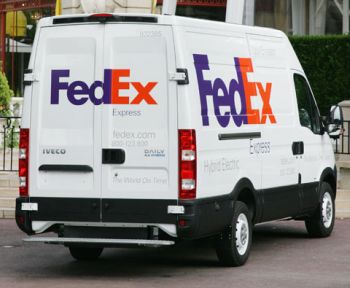 |
|
The
Iveco Daily Hybrid Van (seen above in
service with parcel courier firm FedEx) is a
vehicle with a diesel-electric parallel
hybrid propulsion system, designed to reduce
fuel consumption by up to 30% in urban goods
distribution and collection work, compared
to vehicles with traditional power trains. |
|
|
|
Iveco
participated in the 14th United Nations Climate
Change Conference and Exhibition held in Poznan,
Poland, earlier this month. As a leader in the field of natural gas commercial vehicles,
Iveco exhibited Daily hybrid and electric models. Fiat
Group presents most innovative and
environmentally-friendly solutions reaffirming its
commitment to sustainable and accessible mobility.
Iveco believes that natural gas vehicles represent,
today, the most appropriate solution for urban
transport, efficient and at a sustainable cost.
Iveco is moreover, committed to the development of
alternative traction systems such as electric and hybrid
vehicles that are able to operate with zero or very low
emissions at point of use as well as making significant
contributions to reducing transport CO2 emissions.
Products on show
The Daily Hybrid Van is a vehicle with a
diesel-electric parallel hybrid propulsion system,
designed to reduce fuel consumption by up to 30% in
urban goods distribution and collection work, compared
to vehicles with traditional power trains. The F1A 2300
JTD Intercooler with maximum power of 85cv works in
combination with a 60cv (32kW) electric motor-generator,
a 6-speed automated gearbox and a nickel-metal hydride
battery pack of rated capacity 1.9 kWh. System operating
features include starting from a standstill in electric
mode only, automatic starting of Diesel engine on the
basis of driver performance requirement, power assist
from electric motor during acceleration and climbing,
Stop & Start function and regenerative braking. The
payload is only 200 kg less than conventional Diesel
powered models. A further innovation in this vehicle is
the automatic engagement of the engine brake during
deceleration, in advance of the application of the
foundation brake.
The Minibus Electric Daily A50C/E is Iveco’s
answer to urban mobility with “zero” local emissions,
thanks to an electric traction motor-generator and a
high specific energy sodium battery system (NaNi/Cl2).
The three-phase asynchronous electric motor is inverter
controlled and has the task of directly moving the
vehicle and recovering energy when braking. This energy
efficiency makes it possible to prolong the operating
range, which can be more than 100 km in urban mission.
The MY2006 Minibus A50C/E model has an all-electric
drive and is designed specifically for urban use.
According to the required range, the unit can be made up
of either two or three sodium-nickel-chloride batteries.
Maximum speed is 70 km/h with a maximum laden
gradeability of 16%. Peak motor power is 80 Kw. The
braking system includes hydraulic disc brakes, ABS and
servo assistance, with a vacuum pump operated by an
electric motor. The electricity generated during braking
is used to recharge the batteries in a brake energy
recovery system. All systems linked to the electrical
propulsion are controlled by an electronic management
unit that communicates with them via a controller-area
network (CAN) developed by Iveco. The vehicle is
perfectly suitable for most common urban missions
(cruise service, taxi on call, school bus, etc.).
Sustainable mobility: a key role in Iveco’s
strategy
Sustainable mobility plays a key role in Iveco’s
corporate strategy. Well aware of the importance of
sustainable mobility and in an effort to provide
products that are tailored to customers’ needs, Iveco
proposes a number of highly innovative technological
solutions:
• Natural gas vehicles. Natural gas engines are
among the cleanest available in the market. They are as
quiet as standard petrol engines and emit reduced levels
of CO2. Iveco is European leader in the field of natural
gas powered commercial vehicles. Its product range
principally consists of vehicles for urban use: a vast
array of buses, the Daily, the Stralis and, from 2009,
the Eurocargo. As of today, a total of over 10,000 Iveco
natural gas vehicles are in operation worldwide.
• Renewable fuels. Biogas – derived from
decomposing organic matter as well as gas derived from
fossil fuels – is readily usable on Iveco vehicles, and
so is biodiesel which can be used in blends of up to 5%
with fossil fuel diesel with no need for after-market
modifications. The future of biofuel is the
second-generation renewable bio-fuels, namely BTL
(Biomass-To-Liquid) and HVO (Hydrogenated Vegetable
Oil). Iveco supports the development of BTL and HVO so
as to promote their increased availability.
• Alternative traction. The synergy between an
electric motor and a thermal motor and the recovery of
kinetic energy produced from braking enable Iveco’s
hybrid vehicles to achieve significant savings in fuel
consumption. Compared with traditional vehicles, hybrids
offer reduced noise and significant savings in fuel
consumption, in addition to the possibility - offered by
certain configurations - of driving with zero emissions
in protected urban areas. The Iveco range of serial and
parallel hybrid buses is already operating in numerous
European cities. This technology is also being extended
to freight vehicles. In 2008, Iveco – in collaboration
with a number of major customers – initiated an
extensive road testing program on its light and medium
commercial vehicles (Daily and Eurocargo). For urban
use, Iveco also offers an electric version of the Daily
which provides zero emissions, extremely low noise and a
range of up to 120 km.
• Pollutant emissions. Air quality is
fundamental to protecting the environment and public
health. All Iveco vehicles with a GVW of 7 tonnes or
higher are certified to Euro 5 standards which come into
effect in October 2009. In addition, many Tector and
Cursor versions are also available with EEV
certification, the strictest standard currently in
effect in Europe.
|